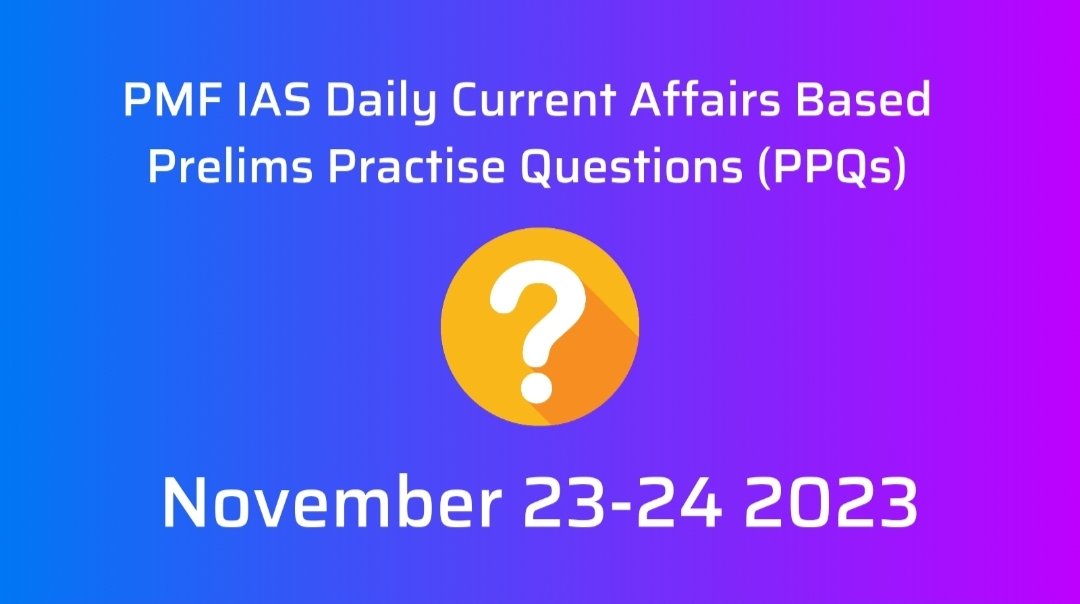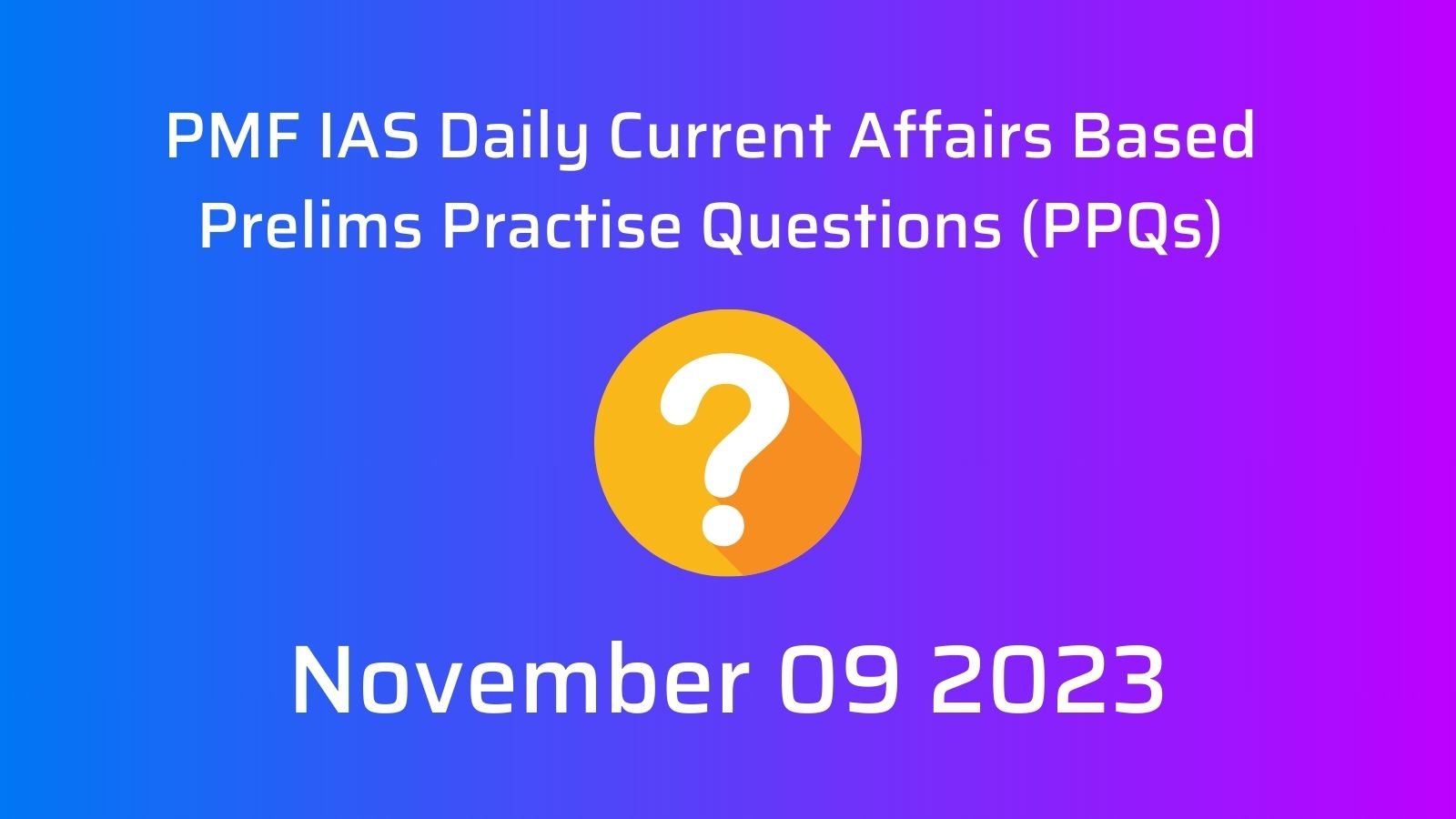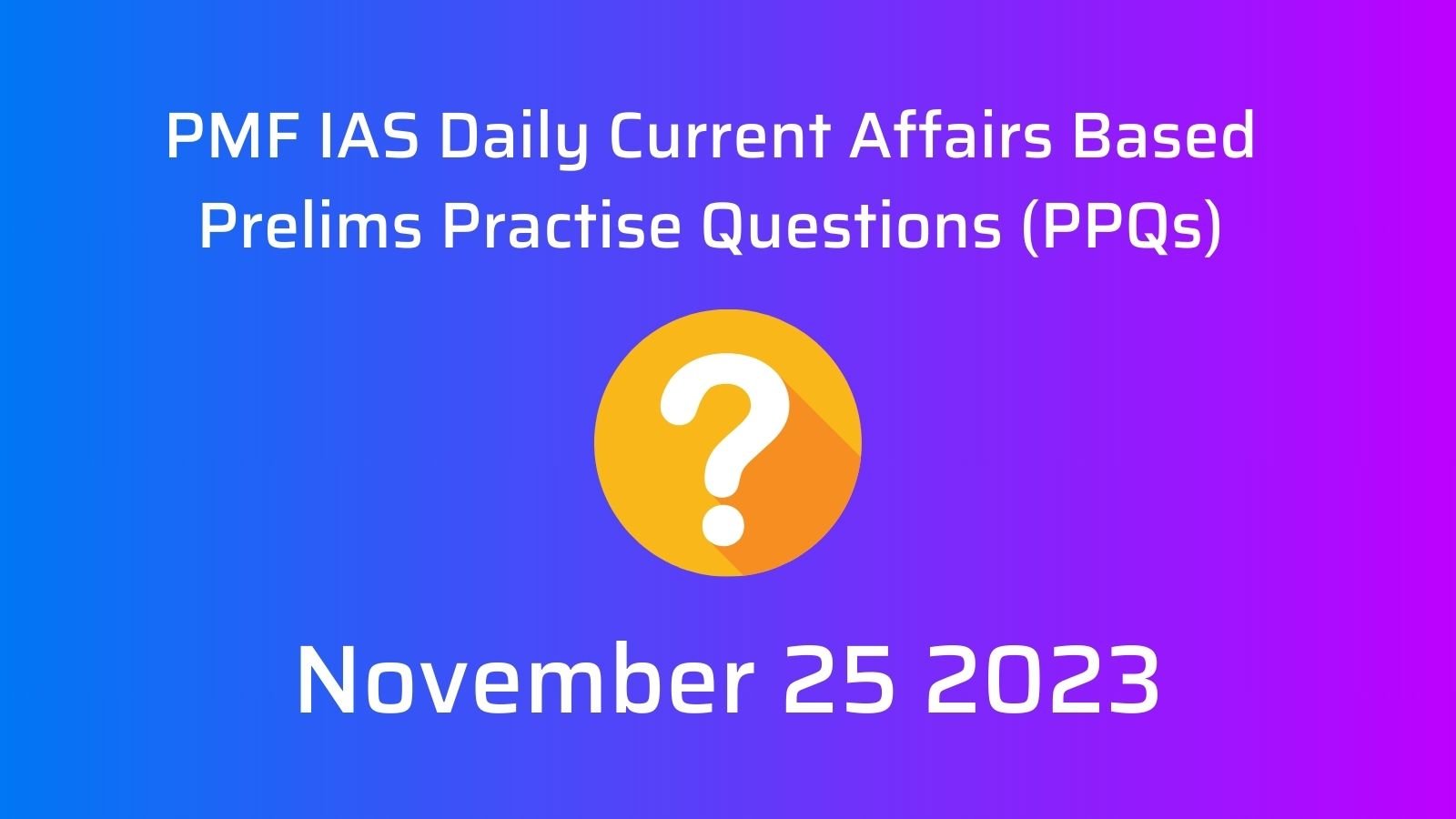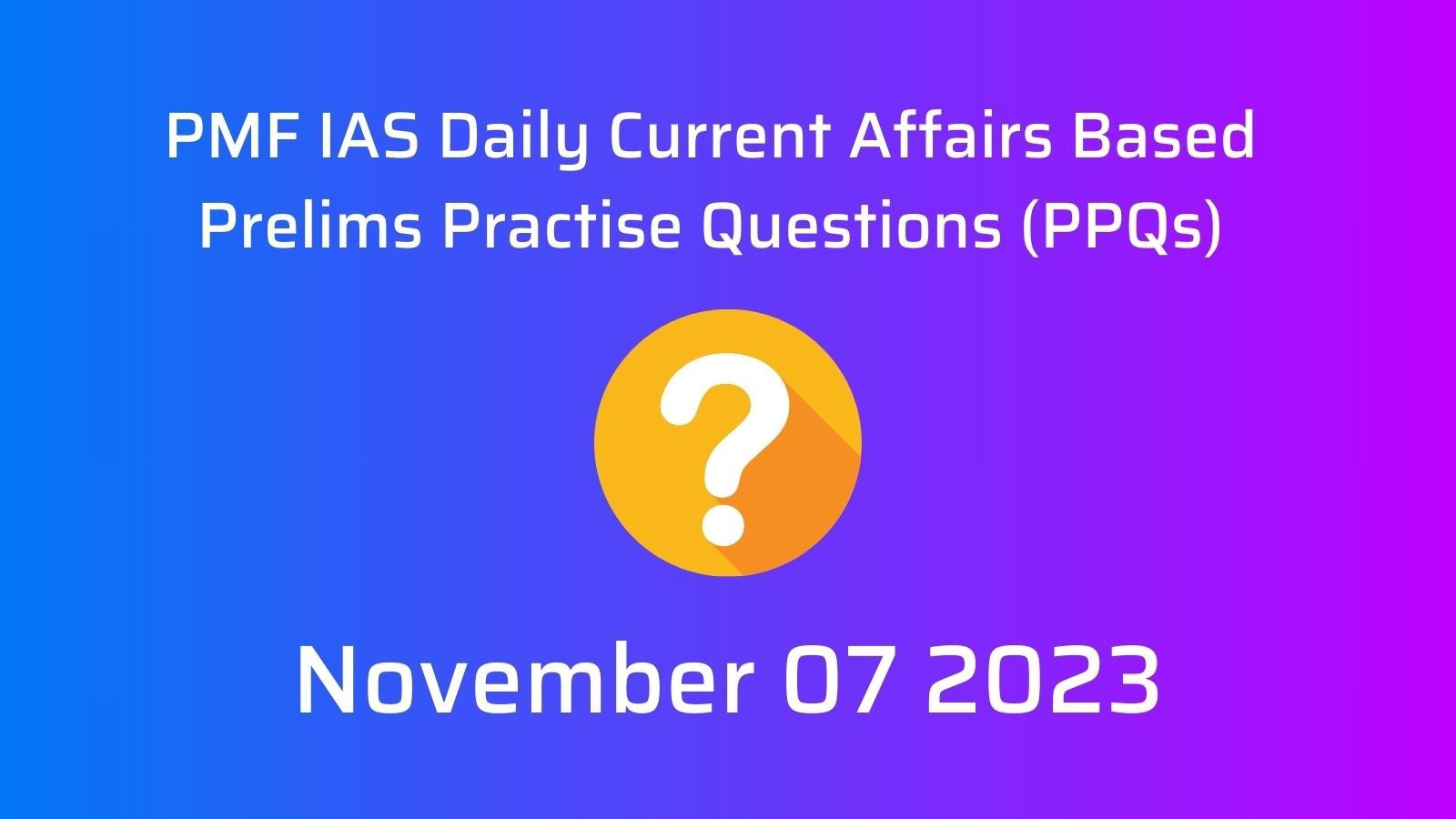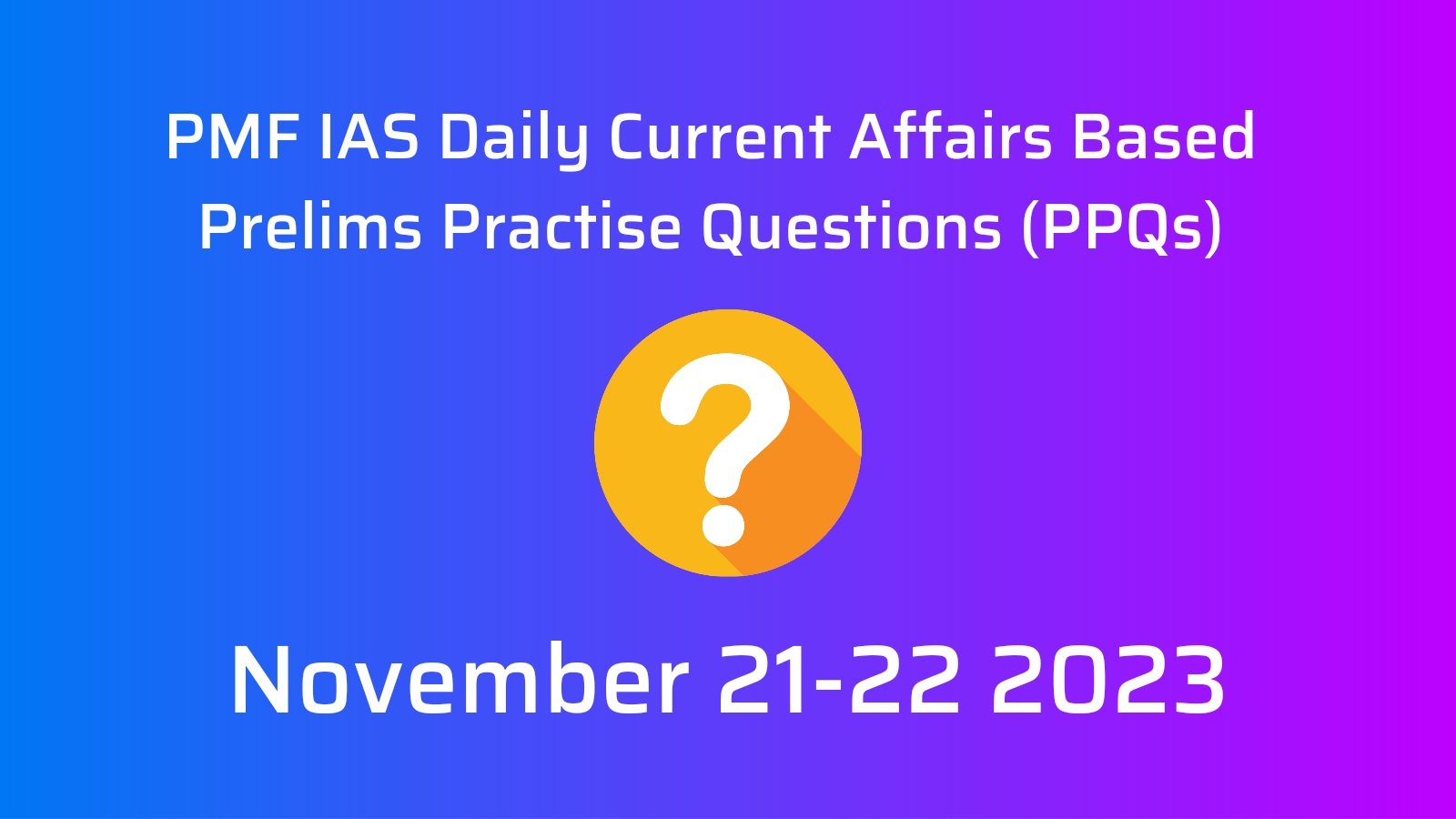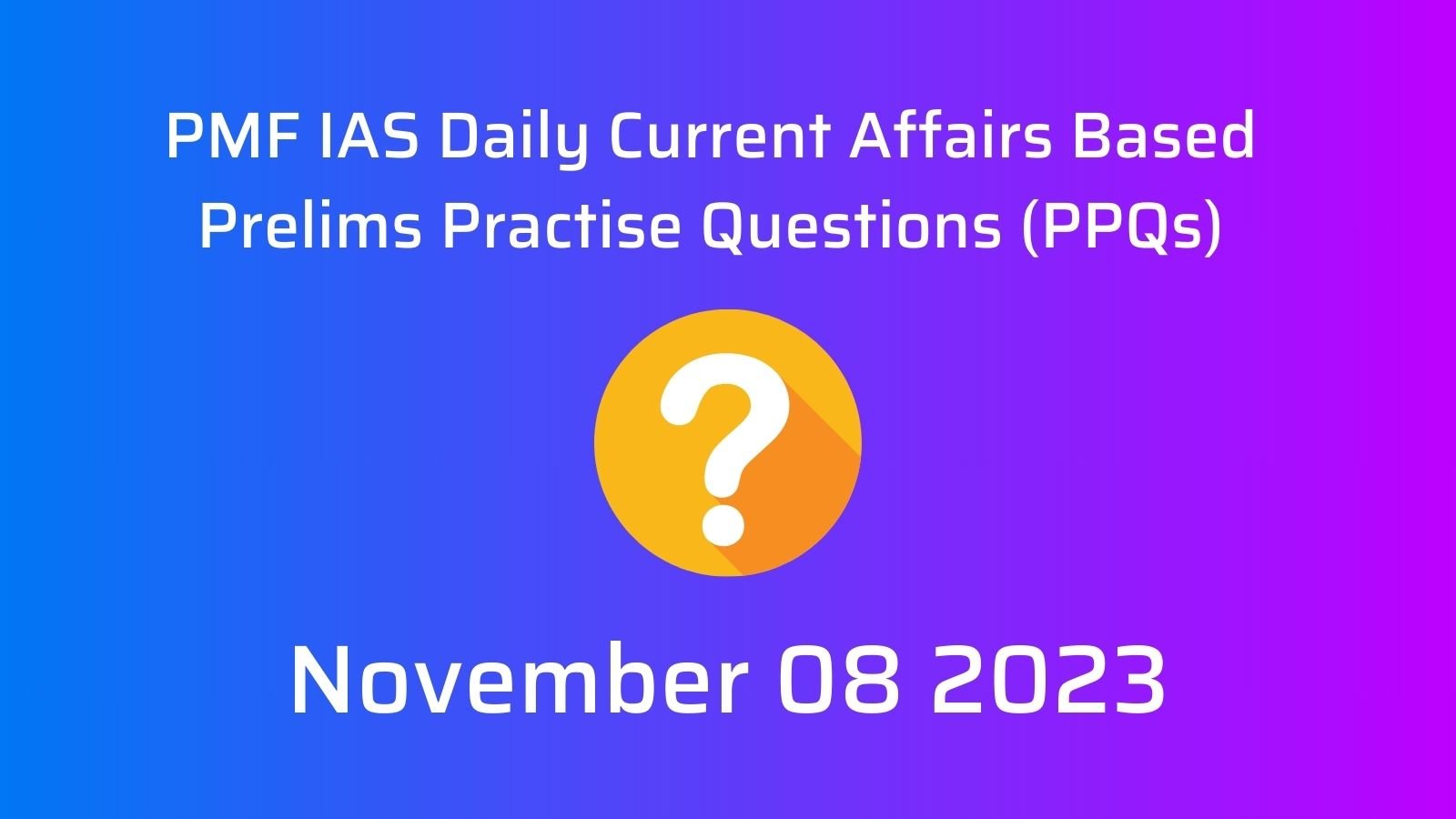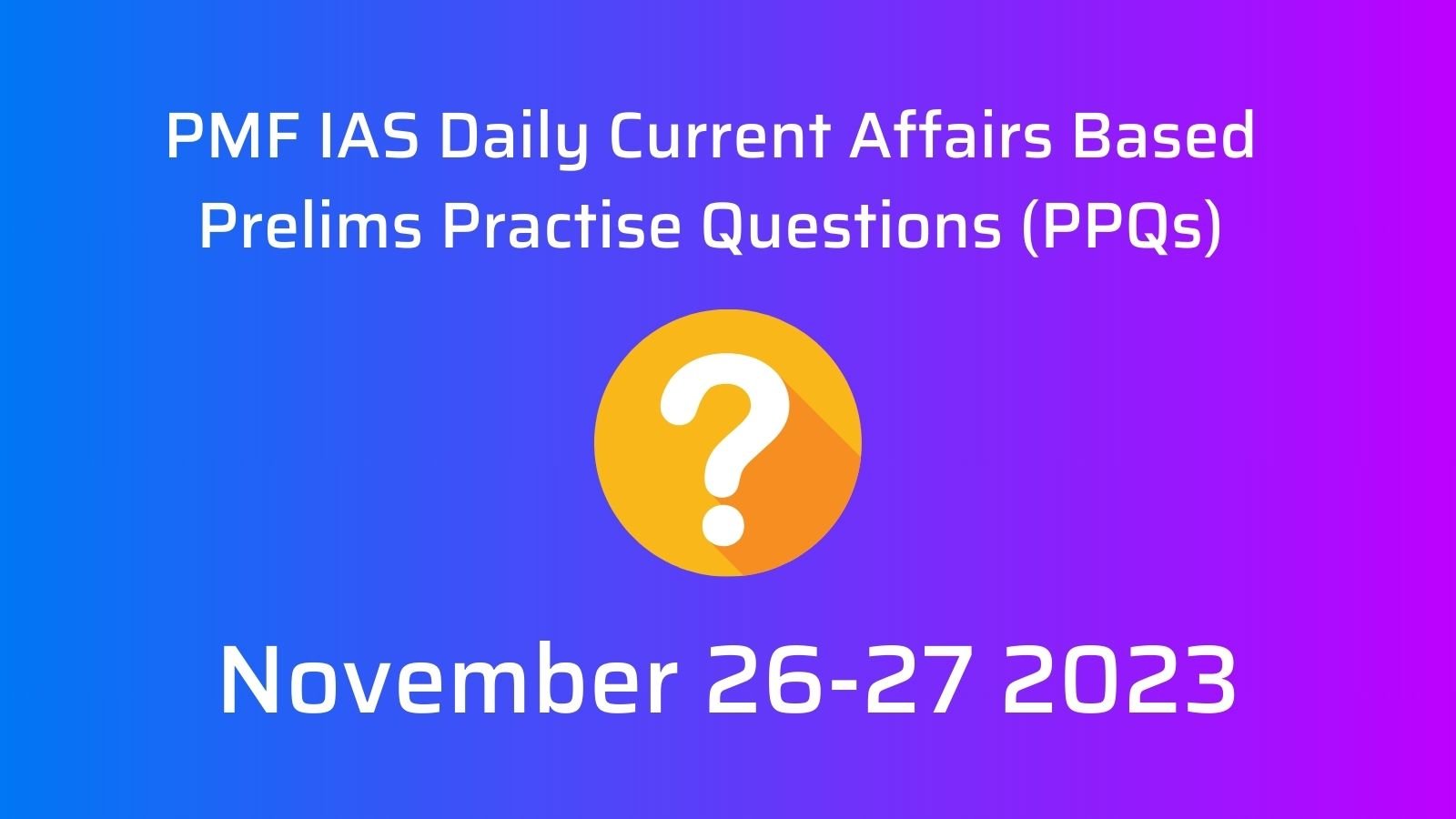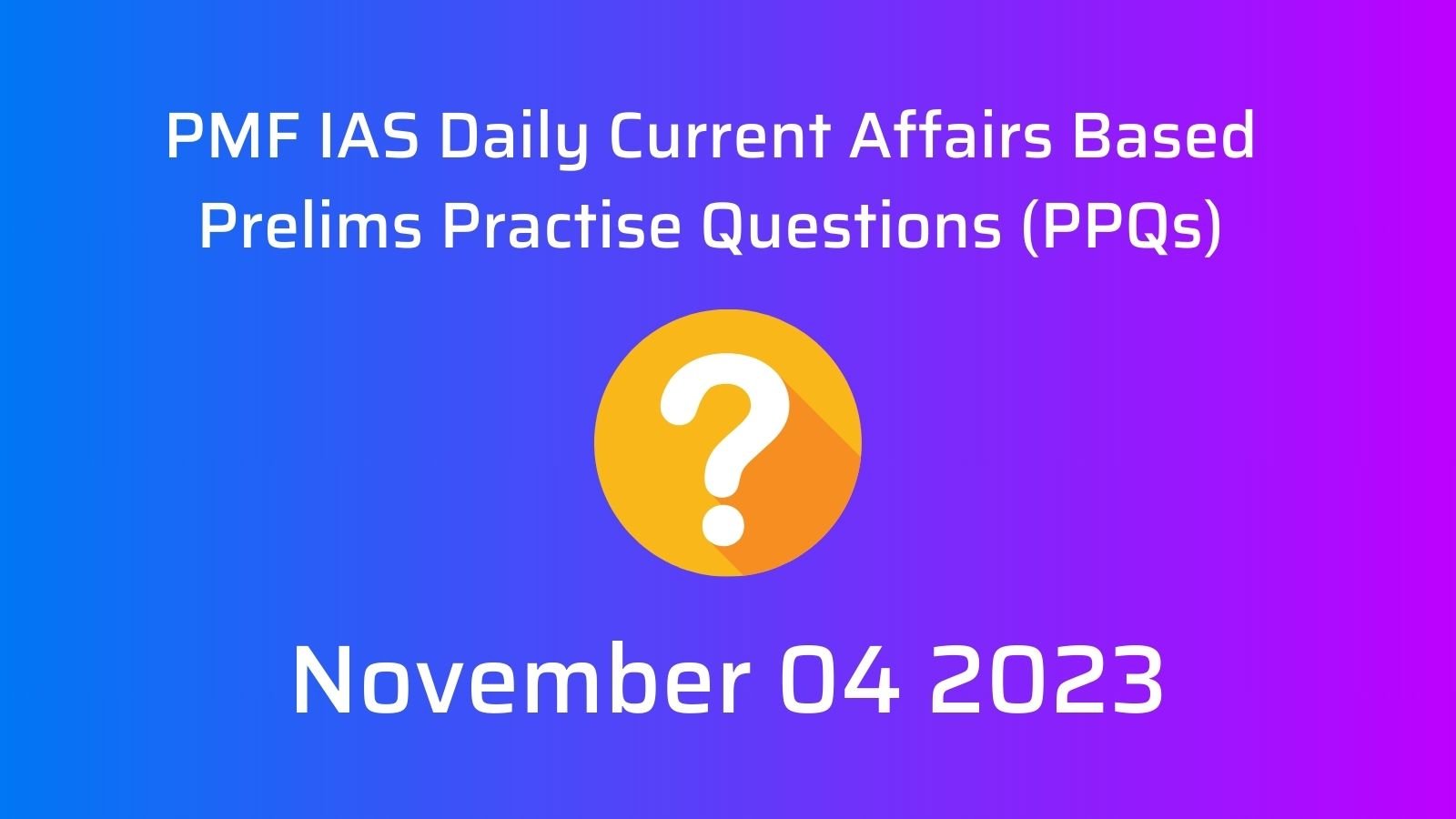
Daily Prelims Practice Questions (PPQs) – November 28-29 2023
Subscribe to Never Miss an Important Update! Assured Discounts on New Products!
Must Join PMF IAS Telegram Channel & PMF IAS History Telegram Channel
Questions
- The questions below are based on PMF IAS Daily Current Affairs – November 2023.
Q1. {MIH – Personalities} Consider the following statements about Senapati Bapat:
- Senapati Bapat disseminated the knowledge of bomb-making amongst the Indian revolutionaries and was arrested in 1912 for the Alipore Bombing.
- In 1915, after his release, he started a newspaper named “Maharatta”.
- In the 1920s, Bapat re-aligned himself with Gandhi’s vision of Swaraj and took a complete oath of Non-Violence, disregarding the thought of Violence in any situation.
- It was Gandhi Ji who gave Bapat the title of Senapati.
How many of the above statement(s) is/are correct?
- Only one
- Only two
- Only three
- All four
Q2. {S&T – IT & Computers} Consider the following statements about Embedded SIM (eSIM):
- Embedded SIM (eSIM) is a type of SIM card embedded directly into a device during manufacturing.
- Through its use, one can make calls and access the internet without physical SIM cards.
- Users can switch carriers and plans without changing SIM cards.
How many of the above statement(s) is/are correct?
- Only one
- Only two
- All three
- None of these
Q3. {Envi – Degradation} Consider the following statements with respect to Rat-Hole Mining:
- Rat-hole mining is a method of extracting coal from narrow, horizontal coal beds. This practice of mining is prevalent in Meghalaya.
- The practice of rat-hole mining is banned in India.
Which of the above statement(s) is/are correct?
- 1 only
- 2 only
- Both 1 and 2
- Neither 1 nor 2
Q4. {Biotech – Gene Editing} Consider the following statements about Gene Editing:
- Gene editing can be used to eliminate genetic differences.
- Casgevy is a revolutionary gene-editing therapy designed to treat sickle cell anemia.
Which of the above statement(s) is/are correct?
- 1 only
- 2 only
- Both 1 and 2
- Neither 1 nor 2
Q5. {Envi – Conservation} Consider the following statements about IUCN:
- Founded in 1948, IUCN is headquartered in Nairobi, Kenya.
- Earlier, the IUCN Red List was divided into 9 categories. Now, Not Evaluated (NE), Data Deficient (DD), and Extinct in the wild (EW) have been removed, making the total to 6.
- The IUCN Red List is continuously reassessed every 10 years.
- In the IUCN Red List, “threatened” includes Critically Endangered, Endangered, and Vulnerable categories.
How many of the above statement(s) is/are incorrect?
- Only one
- Only two
- Only three
- All four
Q6. {IC – Judiciary} Which of the following Amendments empowered the Parliament to make laws for creating One or more All India Services, including an All India Judicial Service (AIJS)?
- 42nd Constitutional Amendment Act, 1976
- 44th Constitutional Amendment Act, 1978
- 61st Constitutional Amendment Act, 1989
- 73rd Constitutional Amendment Act, 1992
Q7. {IR – Multilateral} Consider the following statements with respect to the Indian Ocean Tuna Commission:
- It’s an Organization mandated to manage highly migratory fisheries resources sustainably.
- Its membership is open to Indian Ocean Coastal Countries exclusively.
- Its headquarters is located in Seychelles.
How many of the above statement(s) is/are correct?
- Only one
- Only two
- All three
- None
Q8. {Prelims – Events} Kambala, recently seen in news, is:
- A folk sport practiced in coastal districts where Tulu speakers are the majority
- A Sub-Species of Olive Ridley Turtle to be protected under Operation Kachhap.
- A Fine Quality wool derived from the fine hairs on the underbelly of the Tibetan antelope.
- A Matrilineal Tribe from Telangana.
Q9. {Geo – Minerals} Consider the following statements with reference to Critical Minerals:
- A critical mineral is a metallic element crucial for modern technologies, economies, and national security, with the potential risk of disruptions to its supply chains.
- Only primary minerals are classified to be considered as Critical Minerals.
- In India, lithium reserves are discovered in Gujarat and Odisha.
- Mineral Security Cooperation between India, USA and Australia is part of G7’s Sustainable Critical Minerals Alliance.
How many of the above statement(s) is/are correct?
- Only one
- Only two
- Only three
- All four
Questions with their Answers and Explanation
Q1. {MIH – Personalities} Consider the following statements about Senapati Bapat:
- Senapati Bapat disseminated the knowledge of bomb-making amongst the Indian revolutionaries and was arrested in 1912 for the Alipore Bombing.
- In 1915, after his release, he started a newspaper named “Maharatta”.
- In the 1920s, Bapat re-aligned himself with Gandhi’s vision of Swaraj and took a complete oath of Non-Violence, disregarding the thought of Violence in any situation.
- It was Gandhi Ji who gave Bapat the title of Senapati.
How many of the above statement(s) is/are correct?
- Only one
- Only two
- Only three
- All four
Explanation
Statement 1 is correct
- During his stay in Britain, Senapati Bapat was associated with India House. Here, he met socialist and Russian revolutionaries and with V. D. Savarkar.
- On the advice of V. D. Savarkar, Bapat went to Paris to learn bomb-making techniques.
- Armed with a ’bomb manual’ and two revolvers, Bapat returned to India in 1908.
- He disseminated the knowledge of bomb-making amongst the Indian revolutionaries.
- In 1912, he was arrested in connection with the Alipore bombing and was imprisoned for three years.
Statement 2 is incorrect
- On being released in 1915, Senapati Bapat started working as an assistant editor of the ‘Mahratta’, a newspaper owned by Tilak.
Statement 3 is incorrect
- In the 1920s, Bapat re-aligned himself with Gandhi’s vision of Swaraj.
- He supported and also challenged Mahatma Gandhi.
- Although he took the Gandhian oath of non-violence, he remained willing to use force when necessary.
Statement 4 is incorrect
- In 1921, Bapat led the three-year farmers’ protest (satyagraha) against the construction of the Mulshi Dam by the Tata Company.
- It was his anti-dam Satyagraha that earned him the title of Senapati, which means a ‘commander’.
Answer: (a) Only One | Difficulty Level: Tough (Very Factual)
Q2. {S&T – IT & Computers} Consider the following statements about Embedded SIM (eSIM):
- Embedded SIM (eSIM) is a type of SIM card embedded directly into a device during manufacturing.
- Through its use, one can make calls and access the internet without physical SIM cards.
- Users can switch carriers and plans without changing SIM cards.
How many of the above statement(s) is/are correct?
- Only one
- Only two
- All three
- None of these
Explanation
Statement 1 is correct
- Embedded SIM (eSIM) is a type of SIM card embedded directly into a device, such as a smartphone, tablet, or smartwatch, during manufacturing.
Statement 2 is correct
- It allows one to make calls and access the internet without physical SIM cards.
Statement 3 is correct
- eSIMs enable remote provisioning and activation by carriers, eliminating the need for physical SIM swaps. Users can switch carriers and plans without changing SIM cards.

Answer: (C) All three | Difficulty Level: Easy
Q3. {Envi – Degradation} Consider the following statements with respect to Rat-Hole Mining:
- Rat-hole mining is a method of extracting coal from narrow, horizontal coal beds. This practice of mining is prevalent in Meghalaya.
- The practice of rat-hole mining is banned in India.
Which of the above statement(s) is/are correct?
- 1 only
- 2 only
- Both 1 and 2
- Neither 1 nor 2
Explanations
Statement 1 is correct
- Rat-hole mining is a method of extracting coal from narrow, horizontal coal beds.
- The term “rat hole” refers to the narrow pits dug into the ground, typically just large enough for one person to descend and extract coal.
- Once the pits are dug, miners descend using ropes or bamboo ladders to reach the coal seams. The coal is then manually extracted using primitive tools such as pickaxes, shovels, and baskets.
- Rat hole mining is largely prevalent in Meghalaya, particularly West Jaintia Hills, East Jaintia Hills and West Khasi Hills.
Statement 2 is correct
- Rat hole mining poses significant safety and environmental hazards.
- The mines are typically unregulated and lack safety measures such as proper ventilation, structural support, or safety gear for the workers.
- The mining process can cause land degradation, deforestation, and water pollution.
- The National Green Tribunal (NGT) banned the practice of rat-hole mining in 2014 and retained the ban in 2015.
Answer: (c) Both 1 and 2 | Difficulty Level: Easy (Factual)
Q4. {Biotech – Gene Editing} Consider the following statements about Gene Editing:
- Gene editing can be used to eliminate genetic differences.
- Casgevy is a revolutionary gene-editing therapy designed to treat sickle cell anaemia.
Which of the above statement(s) is/are correct?
- 1 only
- 2 only
- Both 1 and 2
- Neither 1 nor 2
Explanation
Statement 1 is incorrect
- Gene editing is a tool that can be used to modify specific genes in an organism, but it cannot eliminate genetic differences.
- Every individual has a unique genetic makeup, including variations in their DNA sequence responsible for many differences between individuals.
Statement 2 is correct
- Casgevy is a revolutionary gene-editing therapy designed to treat sickle cell anaemia.
- It utilises the advanced CRISPR-Cas 9 tool for editing genes.
- It works by editing the patient’s genes to revive fetal haemoglobin, normally switched off after birth.
- This compensates for the defective haemoglobin in sickle cells, reducing the disease’s severe symptoms and complications.
Answer: (b) 2 only | Difficulty Level: Medium
Q5. {Envi – Conservation} Consider the following statements about IUCN:
- Founded in 1948, IUCN is headquartered in Nairobi, Kenya.
- Earlier, the IUCN Red List was divided into 9 categories. Now, Not Evaluated (NE), Data Deficient (DD), and Extinct in the wild (EW) have been removed, making the total to 6.
- The IUCN Red List is continuously reassessed every 10 years.
- In the IUCN Red List, “threatened” includes Critically Endangered, Endangered, and Vulnerable categories.
How many of the above statement(s) is/are incorrect?
- Only one
- Only two
- Only three
- All four
Explanation
Statement 1 is incorrect
- IUCN was founded in 1948, with its Headquarters in Gland, Switzerland.
Statement 2 is Incorrect
- The IUCN Red List is divided into nine categories:
- Extinct (EX): No longer living anywhere on Earth.
- Extinct in the Wild (EW): Living only in captivity or established in non-native areas.
- Critically Endangered (CR): Facing an extremely high risk of extinction in the wild.
- Endangered (EN): Facing a high risk of extinction in the wild.
- Vulnerable (VU): Facing a moderate risk of extinction in the wild.
- Near Threatened (NT): Likely to become threatened in the near future.
- Least Concern (LC): Evaluated but not currently considered at risk of extinction.
- Data Deficient (DD): There is not enough data to assess its risk of extinction.
- Not Evaluated (NE): Not yet assessed.
Statement 3 is incorrect
- One major issue with the IUCN Red List is that it’s outdated. The recommended 10-year Reassessment has not been done, making up the case for IUCN Red List 2.0.
Statement 4 is correct
- In the IUCN Red List, “threatened” includes Critically Endangered, Endangered, and Vulnerable categories.
Answer: (c) Only three | Difficulty Level: Medium
Q6. {IC – Judiciary} Which of the following Amendments empowered the Parliament to make laws for creating One or more All India Services, including an All India Judicial Service (AIJS)?
- 42nd Constitutional Amendment Act, 1976
- 44th Constitutional Amendment Act, 1978
- 61st Constitutional Amendment Act, 1989
- 73rd Constitutional Amendment Act, 1992
Explanation
- Article 312 of the Constitution, as amended by the 42nd Amendment, creates an AIJS and requires a resolution adopted by the Council of States with a two-thirds majority and a parliamentary law.
- The Constitution recognises that rules governing the subordinate judiciary in the States will have to be superseded by a central law for this proposal (creation of AIJS) to achieve fruition.
-
- 44th Constitutional Amendment Act, 1978 – It is the act passed by the government in the year 1978 to revoke Some amendments made under the 42 amendment act, 1976. The 44th Amendment Act 1978 also safeguards people against the tendency of the majority to make rights in the future.
- 61st Constitutional Amendment Act, 1989 – The Sixty-first Amendment of the Constitution of India, officially known as The Constitution (Sixty-first Amendment) Act, 1988, lowered the voting age of elections to the Lok Sabha and to the Legislative Assemblies of States from 21 years to 18 years.
- 73rd Constitutional Amendment Act, 1992 – The 73rd Constitutional Amendment Act, 1992 deals with Panchayati Raj. The 73rd Amendment envisages the Gram Sabha as the foundation of the Panchayat Raj system, which carries out the functions and powers assigned by the State Legislatures.
Answer: (a) 42nd Constitutional Amendment Act, 1976 | Difficulty Level: Easy (Factual)
Q7. {IR – Multilateral} Consider the following statements with respect to the Indian Ocean Tuna Commission:
- It’s an Organization mandated to manage highly migratory fisheries resources sustainably.
- Its membership is open to Indian Ocean Coastal Countries exclusively.
- Its headquarters is located in Seychelles.
How many of the above statement(s) is/are correct?
- Only one
- Only two
- All three
- None
Explanation
Statement 1 is correct
- Found in warm seas, the tuna is commercially fished extensively as a food fish.
- The Indian Ocean Tuna Commission (IOTC) is an intergovernmental organization responsible for managing tuna and tuna-like species in the Indian Ocean.
- It was established in 1993 by the Food and Agriculture Organization of the UN.
- It is mandated to manage highly migratory (tuna and tuna-like) fisheries resources sustainably in the Indian Ocean.
Statement 2 is incorrect
- IOTC Members can make decisions concerning managing tuna and tuna-like resources and their associated environment binding on all Members and Cooperating non-contracting Parties.
- Membership of the IOTC is open to:
- Indian Ocean coastal countries.
- Countries or Regional economic integration organizations that are members of the UN.
- Countries that are members of UN special organizations.
- Countries that fish for tuna in the Indian Ocean.
Statement 3 is correct
- It’s Headquarter is Located in Victoria, Seychelles.
Answer: (b) Only Two | Difficulty Level: Easy (Factual)
Q8. {Prelims – Events} Kambala, recently seen in news, is:
- A folk sport practiced in coastal districts where Tulu speakers are the majority
- A Sub-Species of Olive Ridley Turtle to be protected under Operation Kachhap.
- A Fine Quality wool derived from the fine hairs on the underbelly of the Tibetan antelope.
- A Matrilineal Tribe from Telangana.
Explanation
- Kambala is a traditional buffalo race in Karnataka.
- It is a folk sport practiced in coastal districts where Tulu speakers are the majority.
- The race is part of a harvest festival held in muddy paddy fields after the harvest.
- Several organizations, including People for the Ethical Treatment of Animals (PETA), filed a petition against traditional sporting events, citing animal abuse.
- In 2016, an exception was made by the Environment Ministry, allowing bulls to be trained as performing animals for traditional events like Jallikattu and Bullock Cart Races in Maharashtra, Karnataka, Punjab, Haryana, Kerala, and Gujarat.
- A five-judge Constitutional Bench upheld the amendments made by Karnataka, Tamil Nadu, and Maharashtra.
Answer: (a) 1 only | Difficulty Level: Easy (Factual)
Q9. {Geo – Minerals} Consider the following statements with reference to Critical Minerals:
- A critical mineral is a metallic element crucial for modern technologies, economies, and national security, with the potential risk of disruptions to its supply chains.
- Only primary minerals are classified to be considered as Critical Minerals.
- In India, lithium reserves are discovered in Gujarat and Odisha.
- Mineral Security Cooperation between India, USA and Australia is part of G7’s Sustainable Critical Minerals Alliance.
How many of the above statement(s) is/are correct?
- Only one
- Only two
- Only three
- All four
Explanation
Statement 1 is incorrect
- A critical mineral is a metallic or non-metallic element crucial for modern technologies, economies, and national security, with the potential risk of disruptions to its supply chains.
- Countries create their own critical minerals list based on strategic needs.
Statement 2 is incorrect
- It includes both primary (raw mineral) and processed minerals.
Statement 3 is incorrect
- In India, lithium reserves are discovered in J&K and Rajasthan.
- Chile holds the world’s largest lithium reserves and is the world’s second-largest producer.
- India imports 80 per cent of its lithium and 85 per cent of its cobalt from China.
Statement 4 is correct
- Mineral Security Cooperation between India, USA and Australia is a part of G7’s Sustainable Critical Minerals Alliance.





![PMF IAS Environment for UPSC 2022-23 [paperback] PMF IAS [Nov 30, 2021]…](https://pmfias.b-cdn.net/wp-content/uploads/2024/04/pmfiasenvironmentforupsc2022-23paperbackpmfiasnov302021.jpg)
